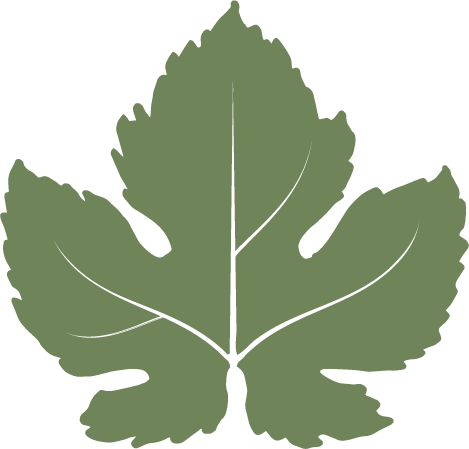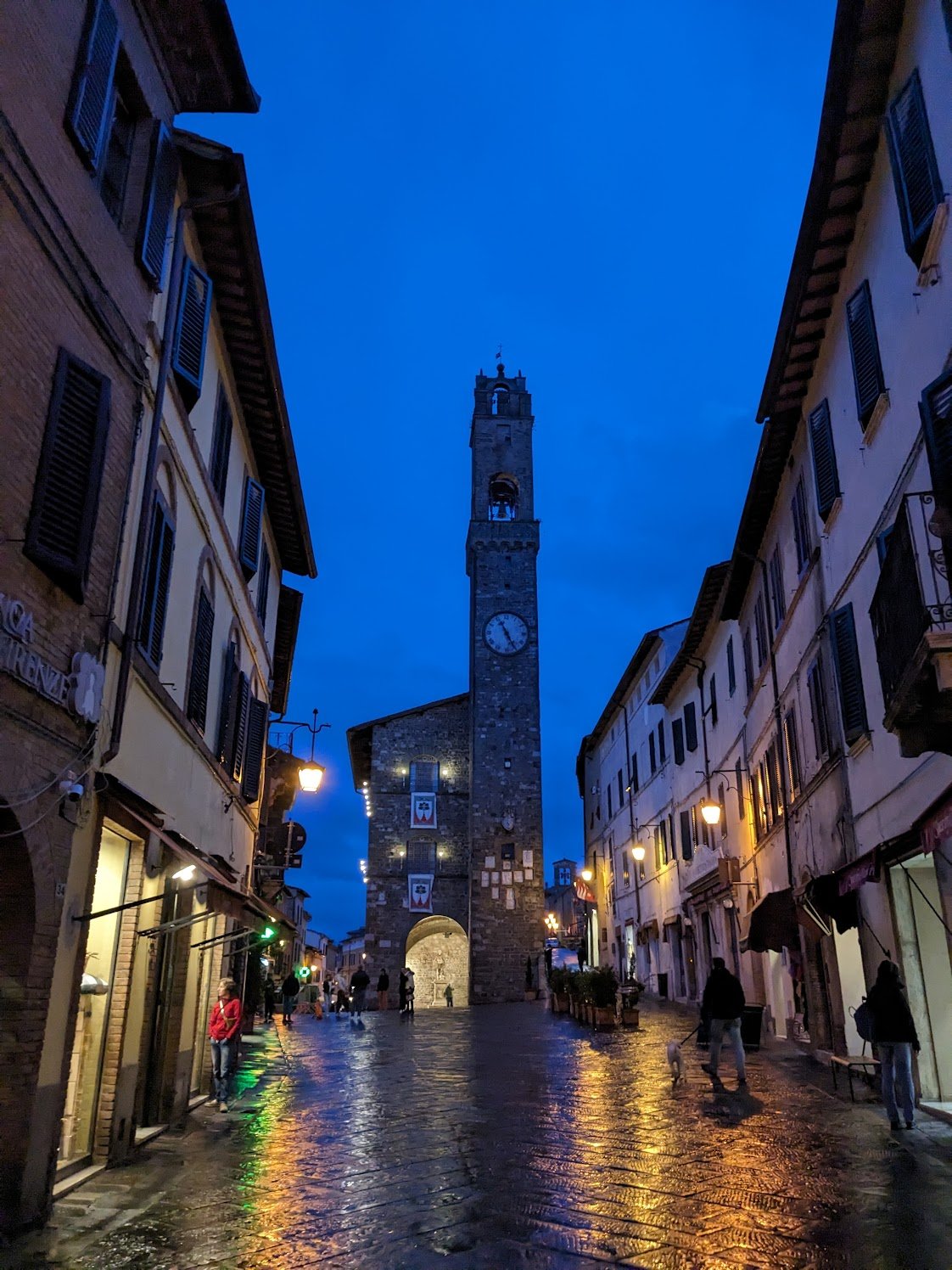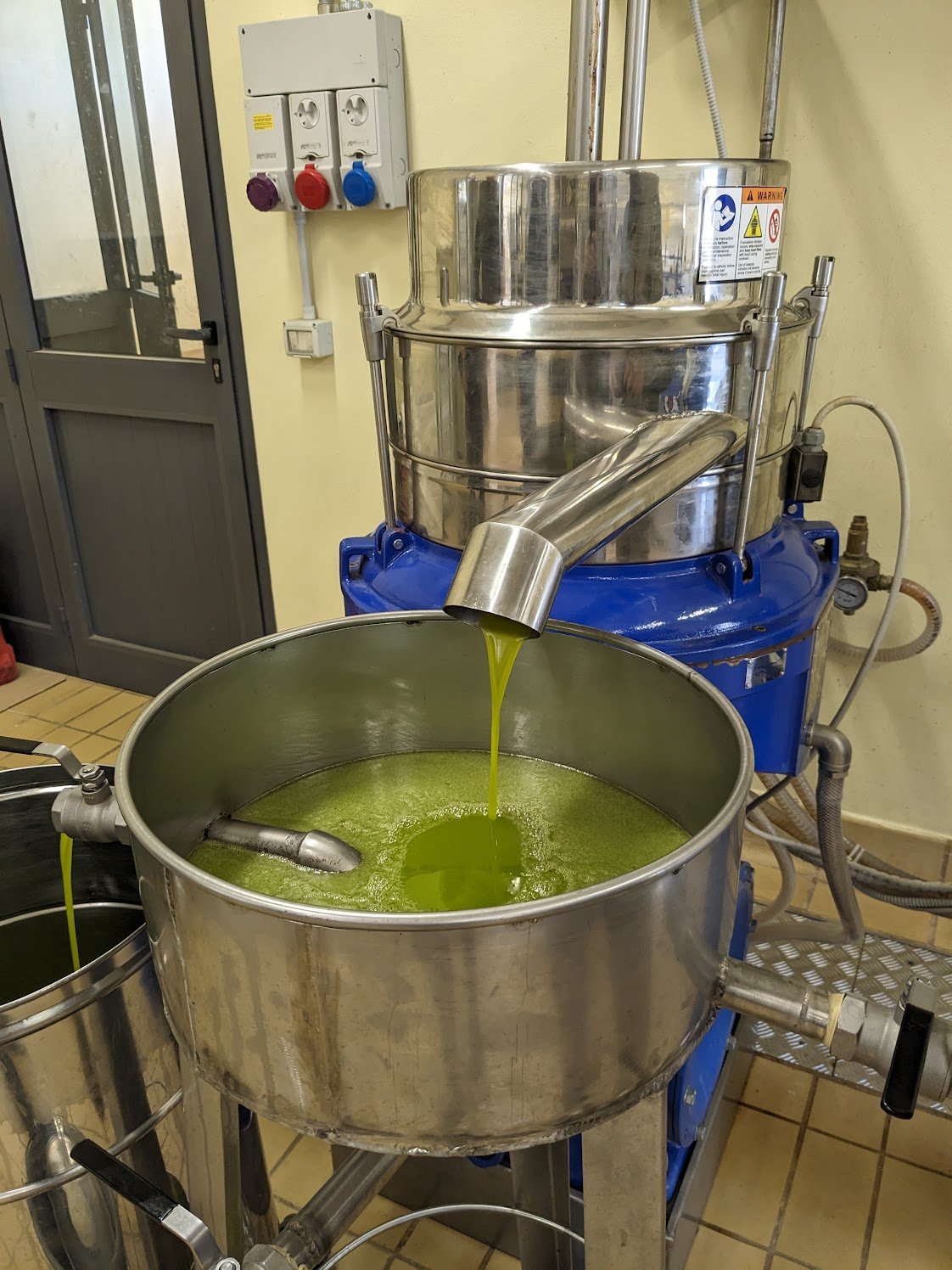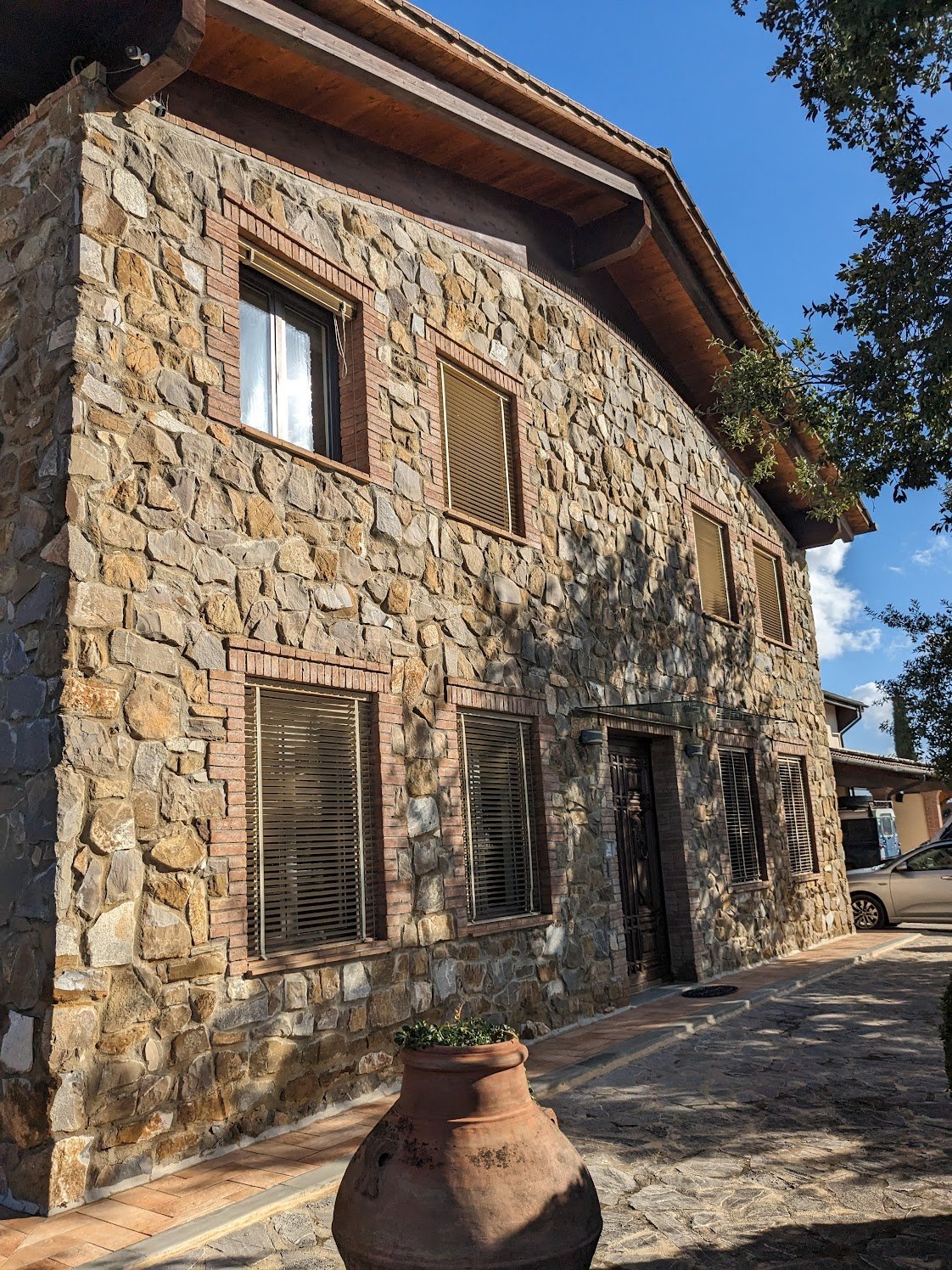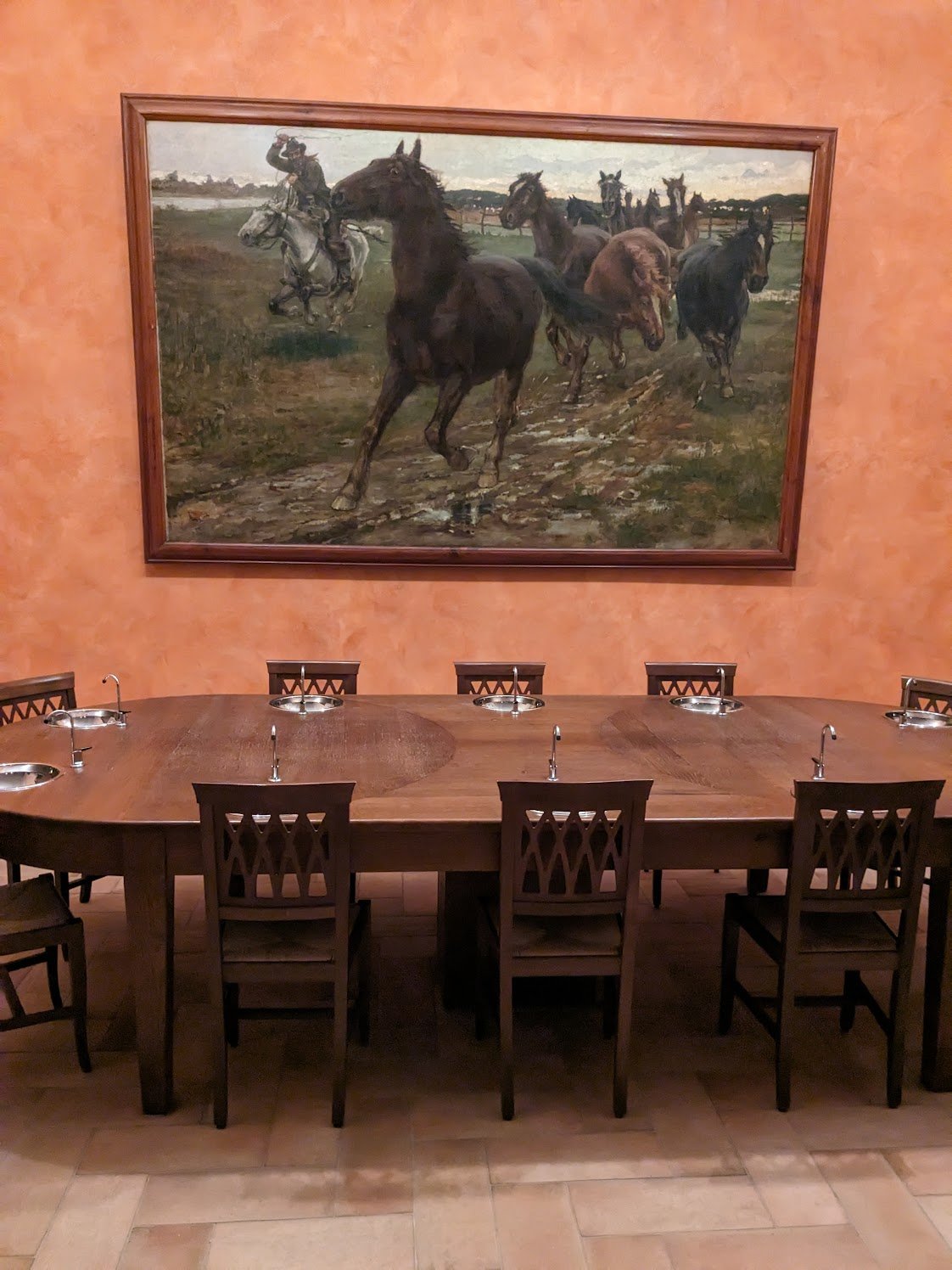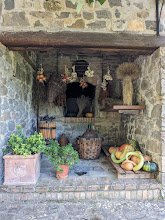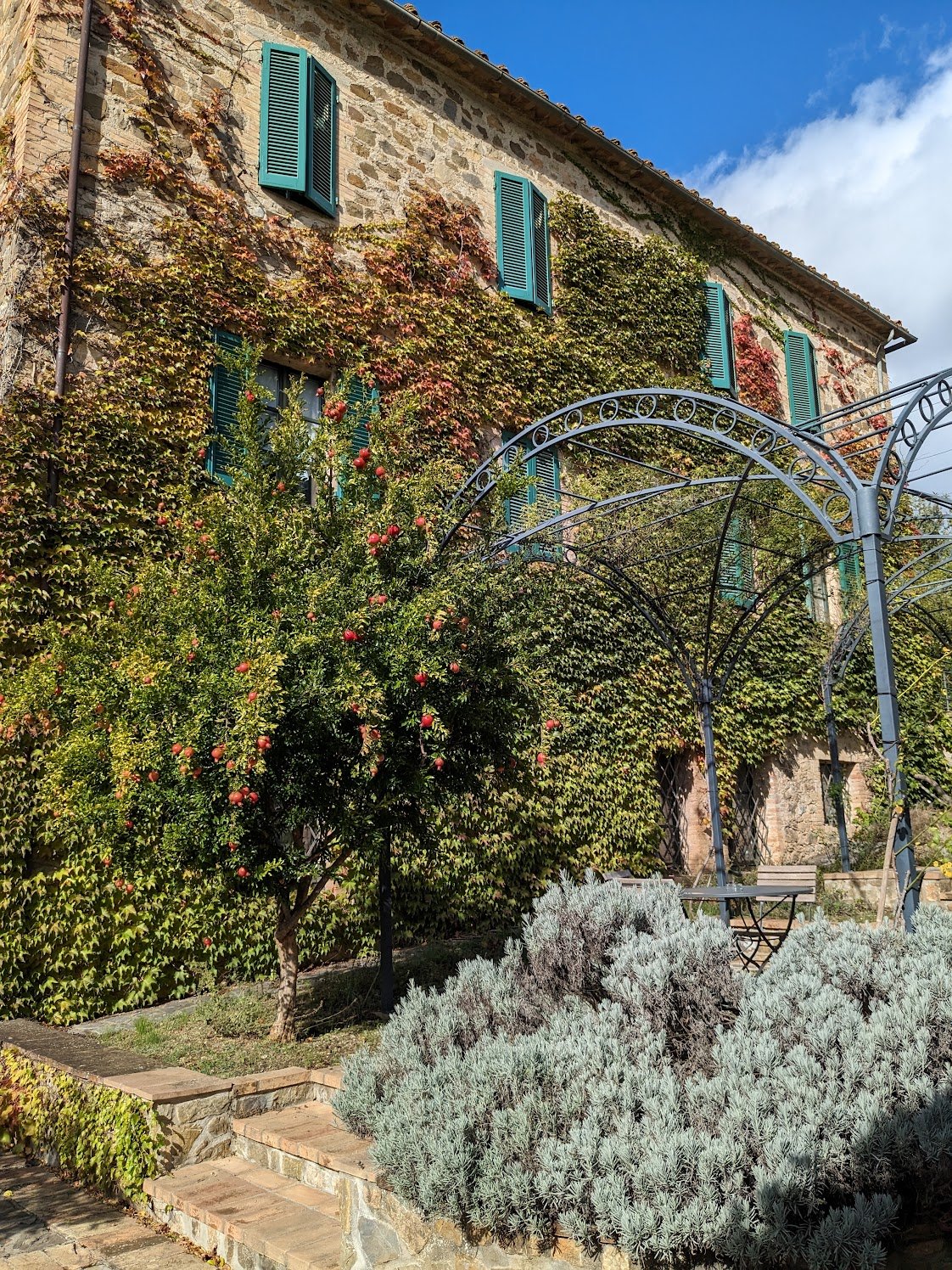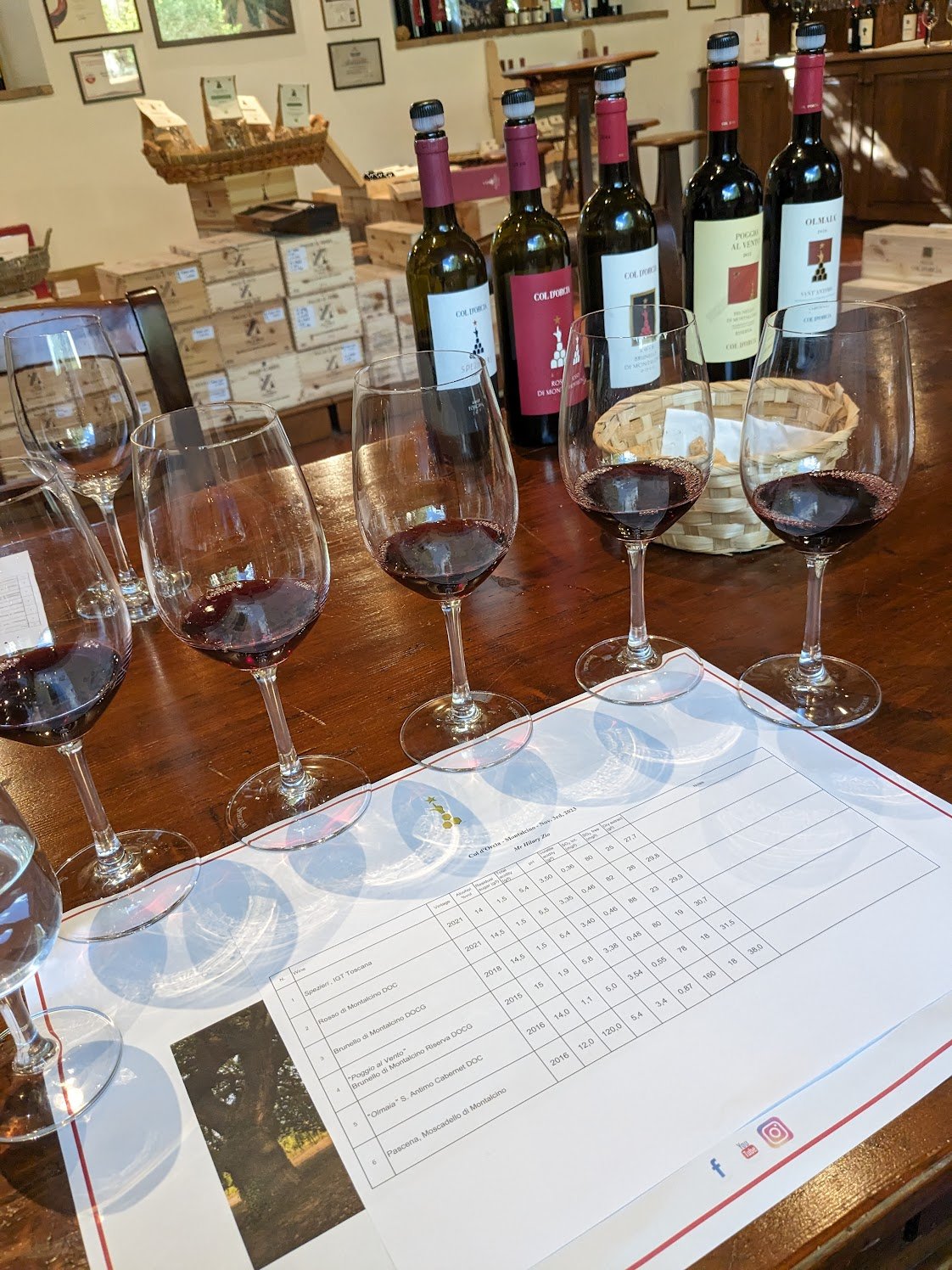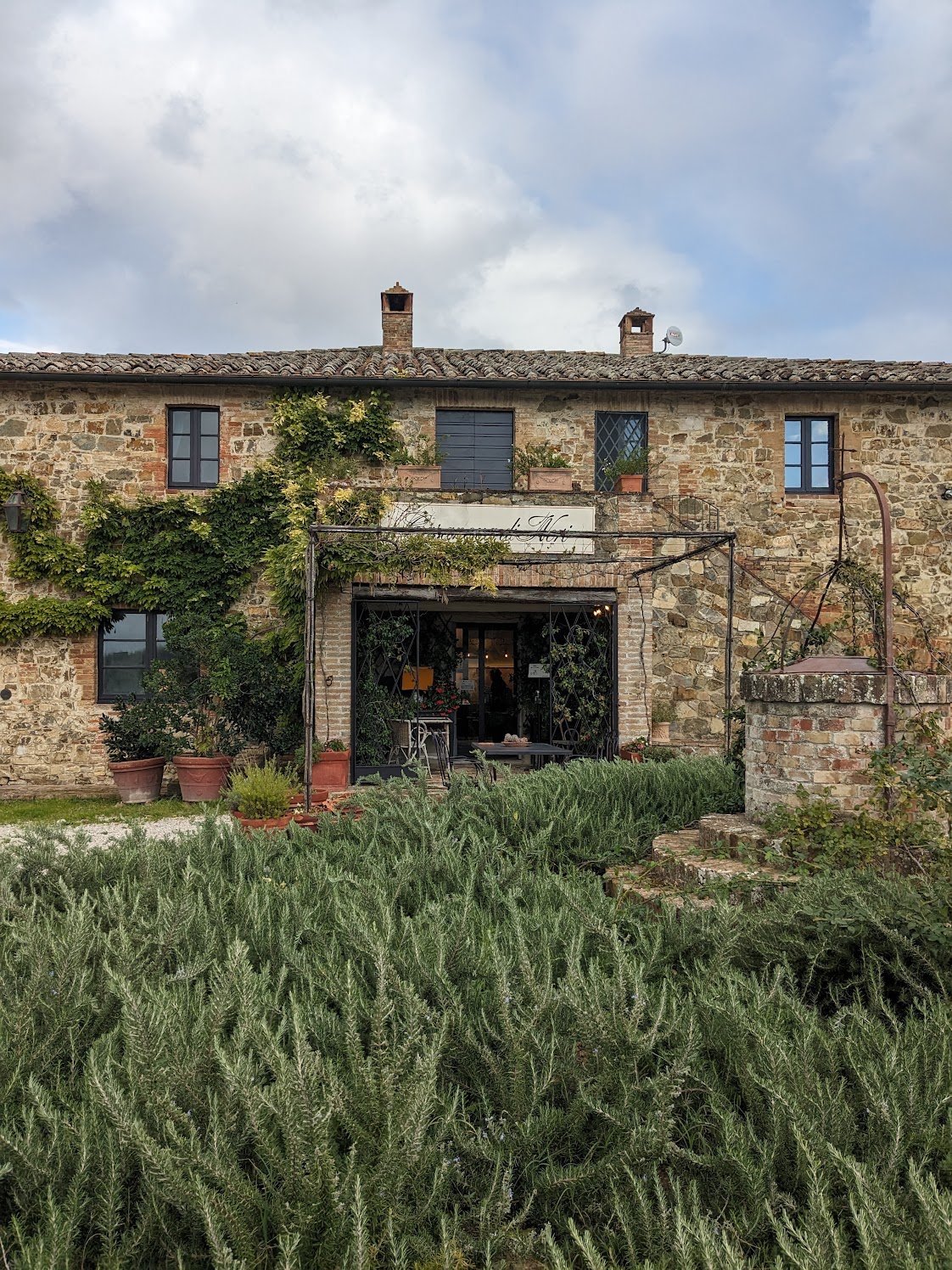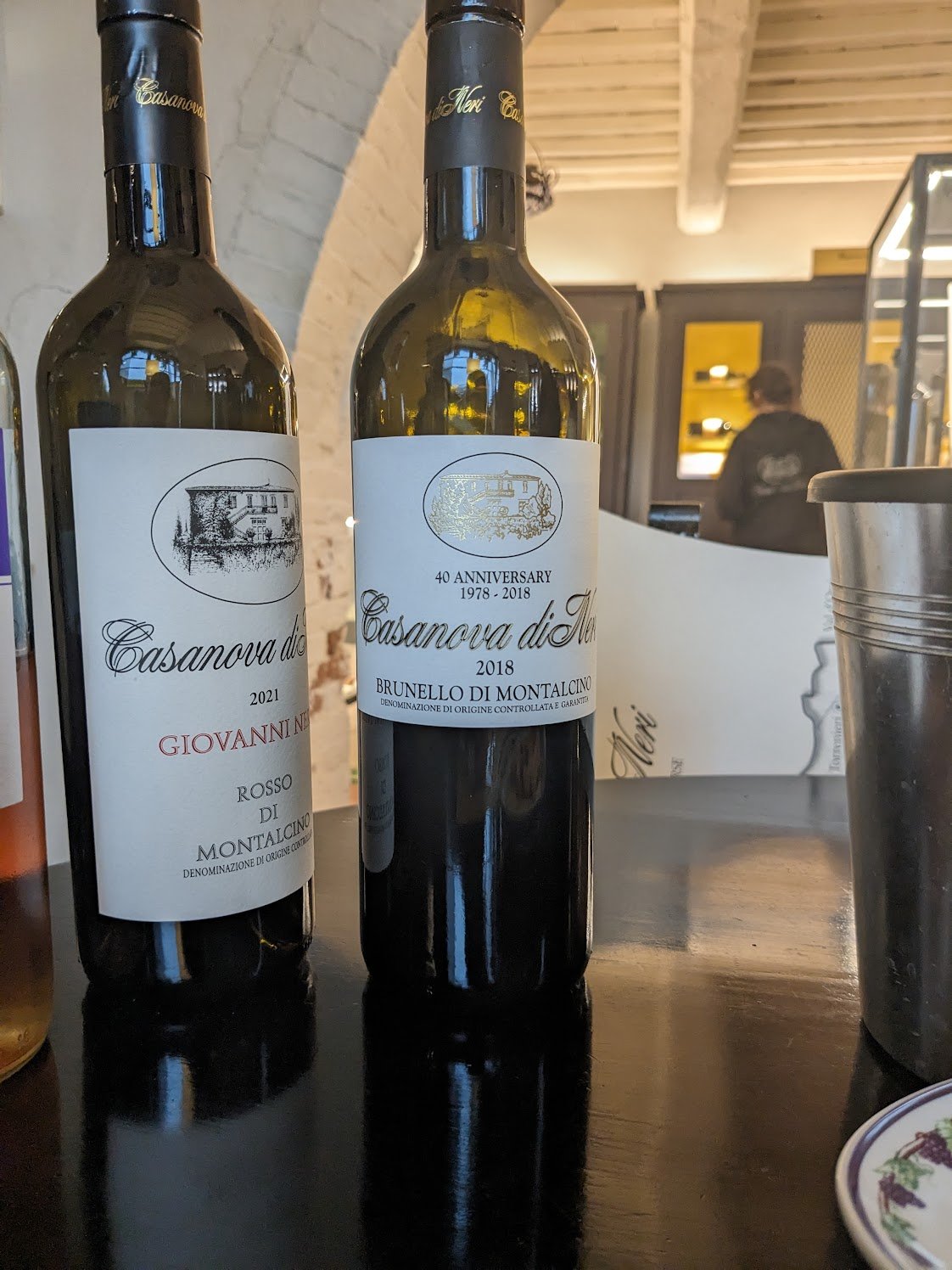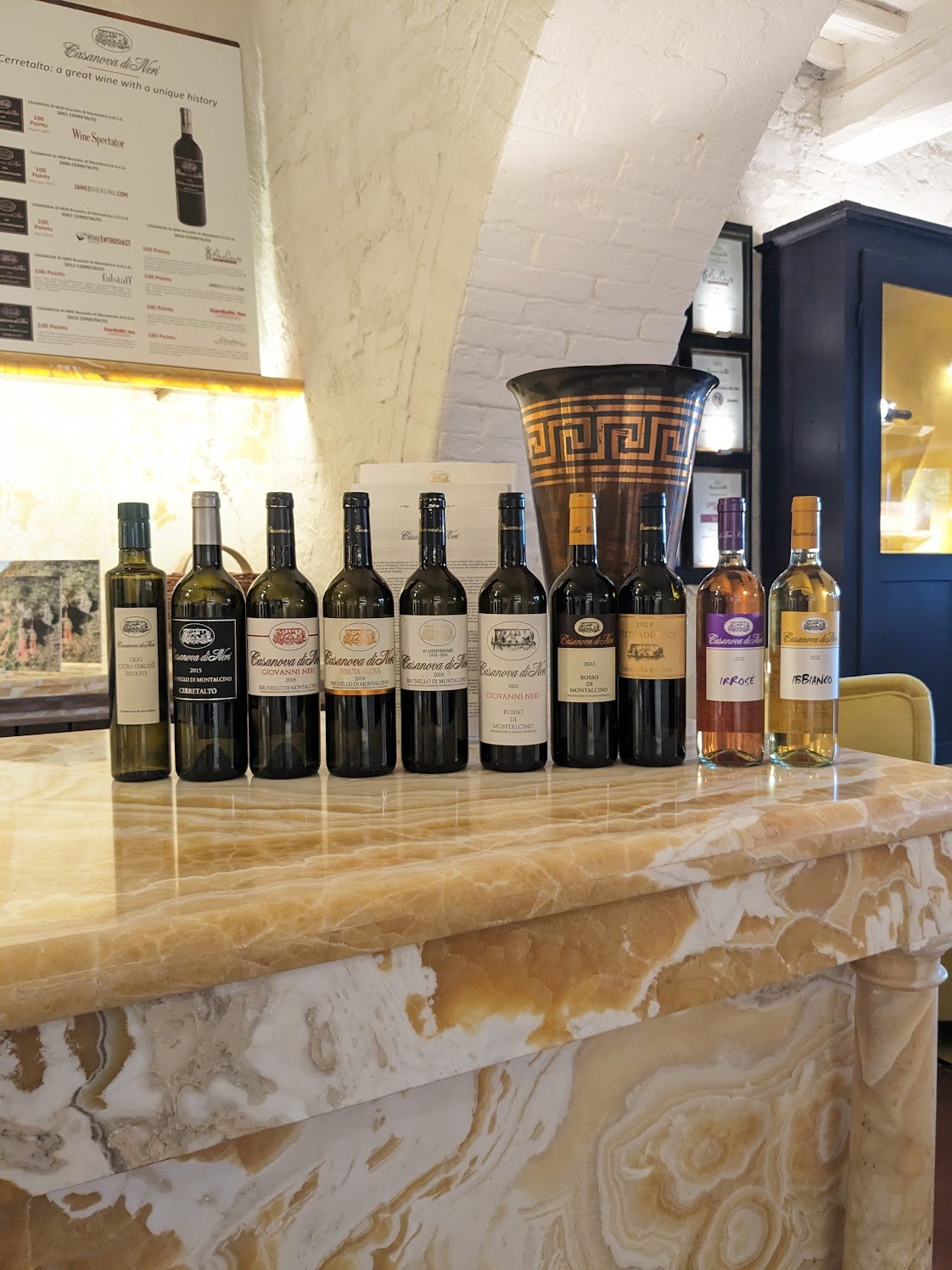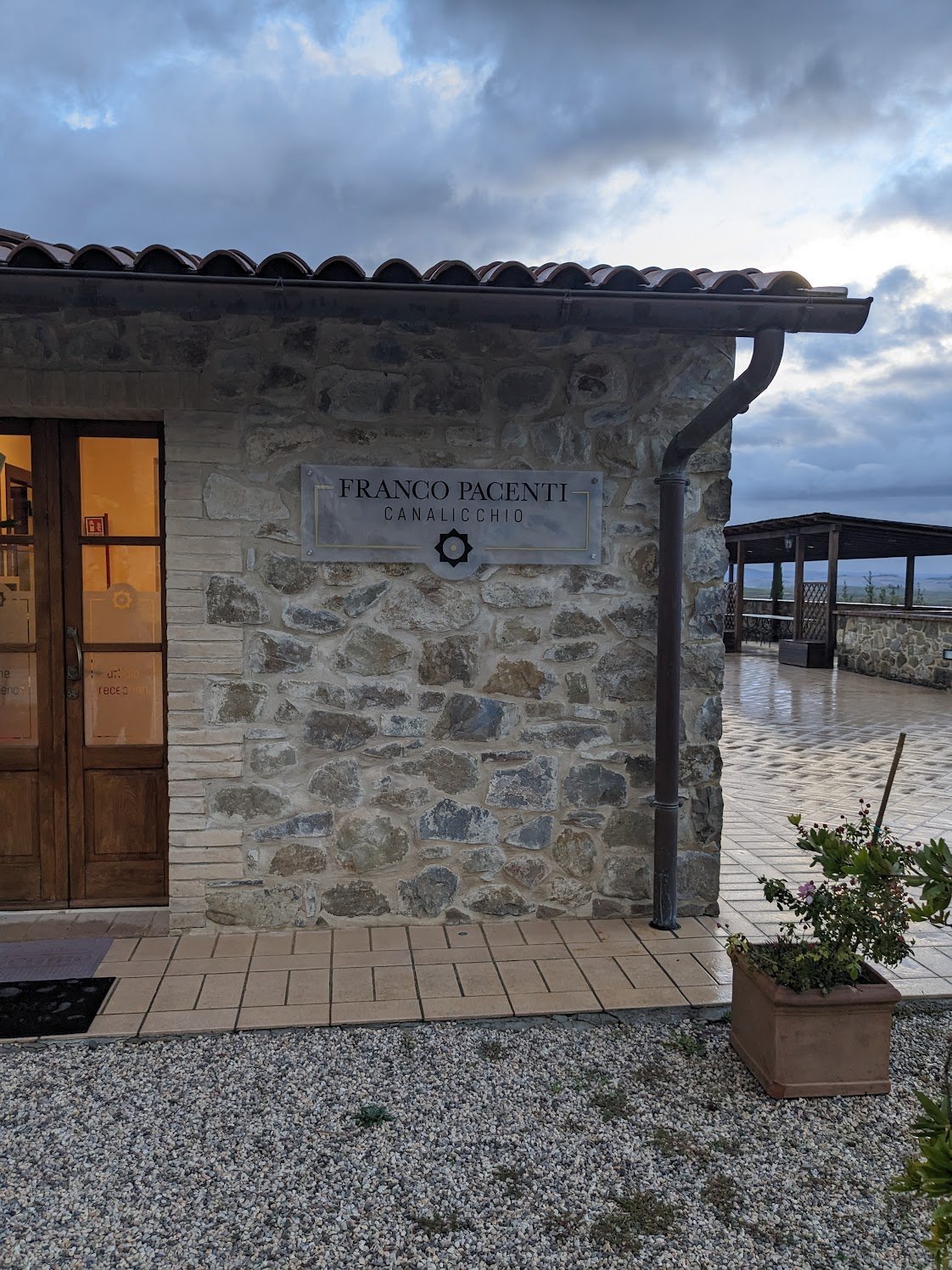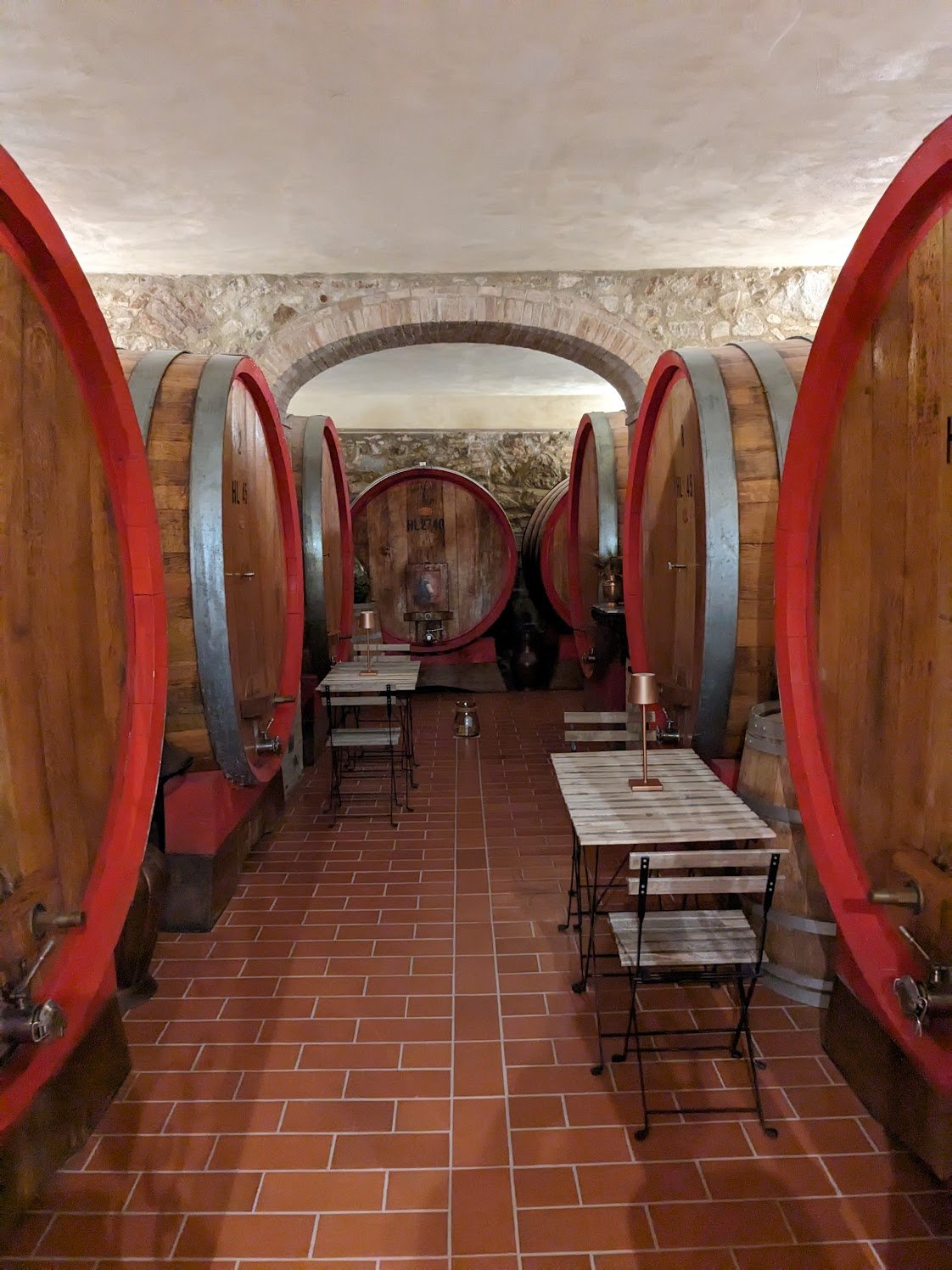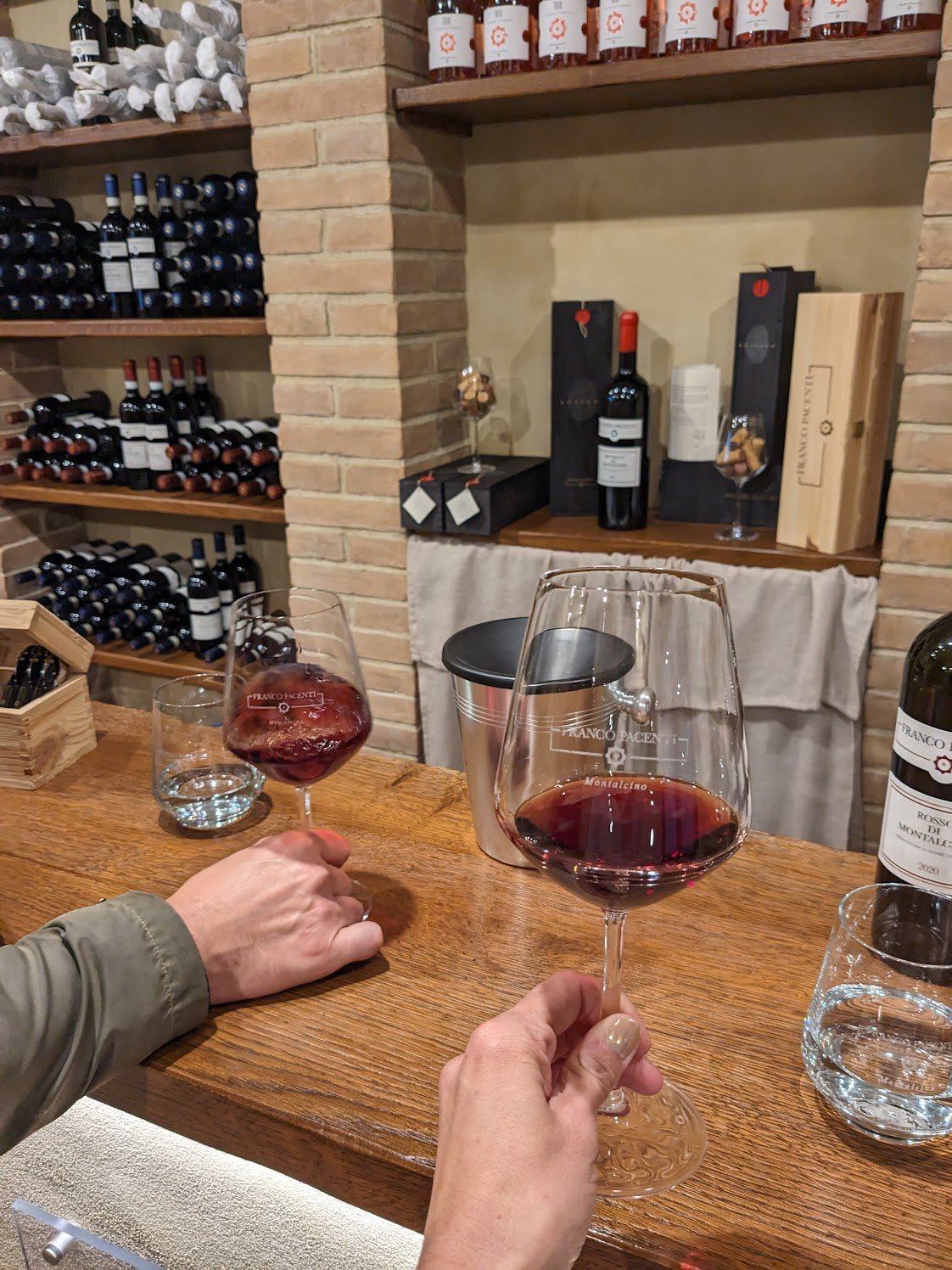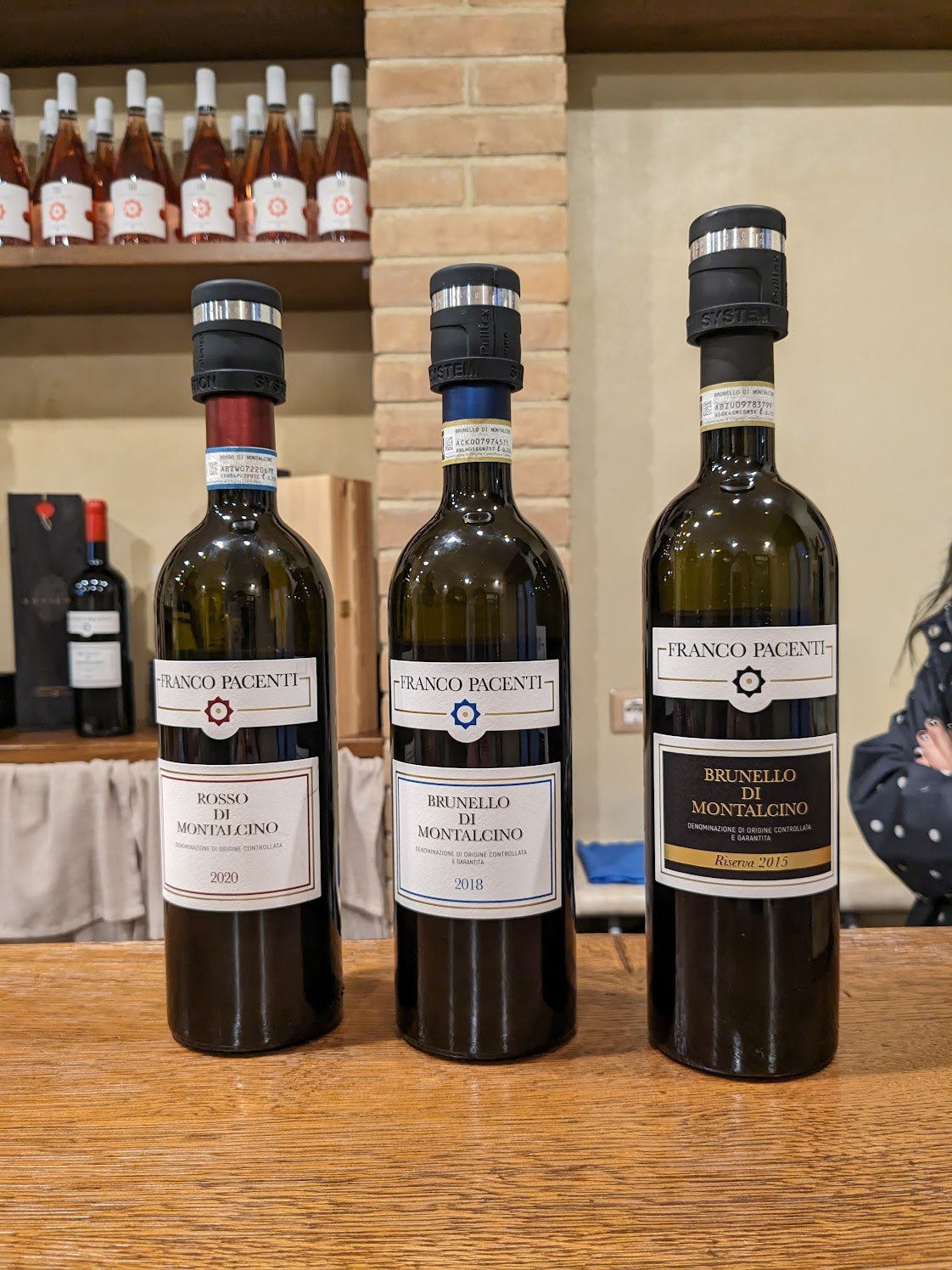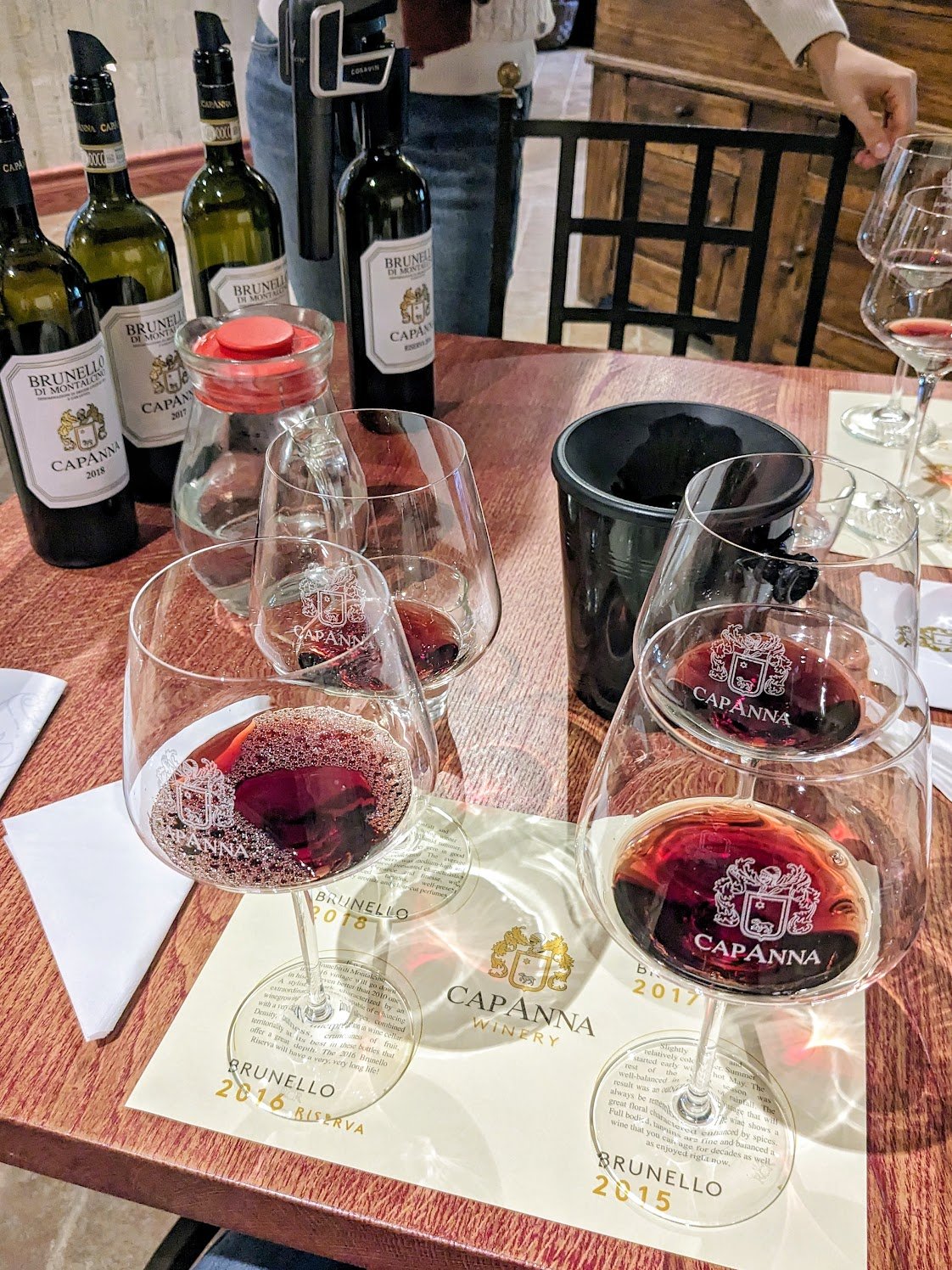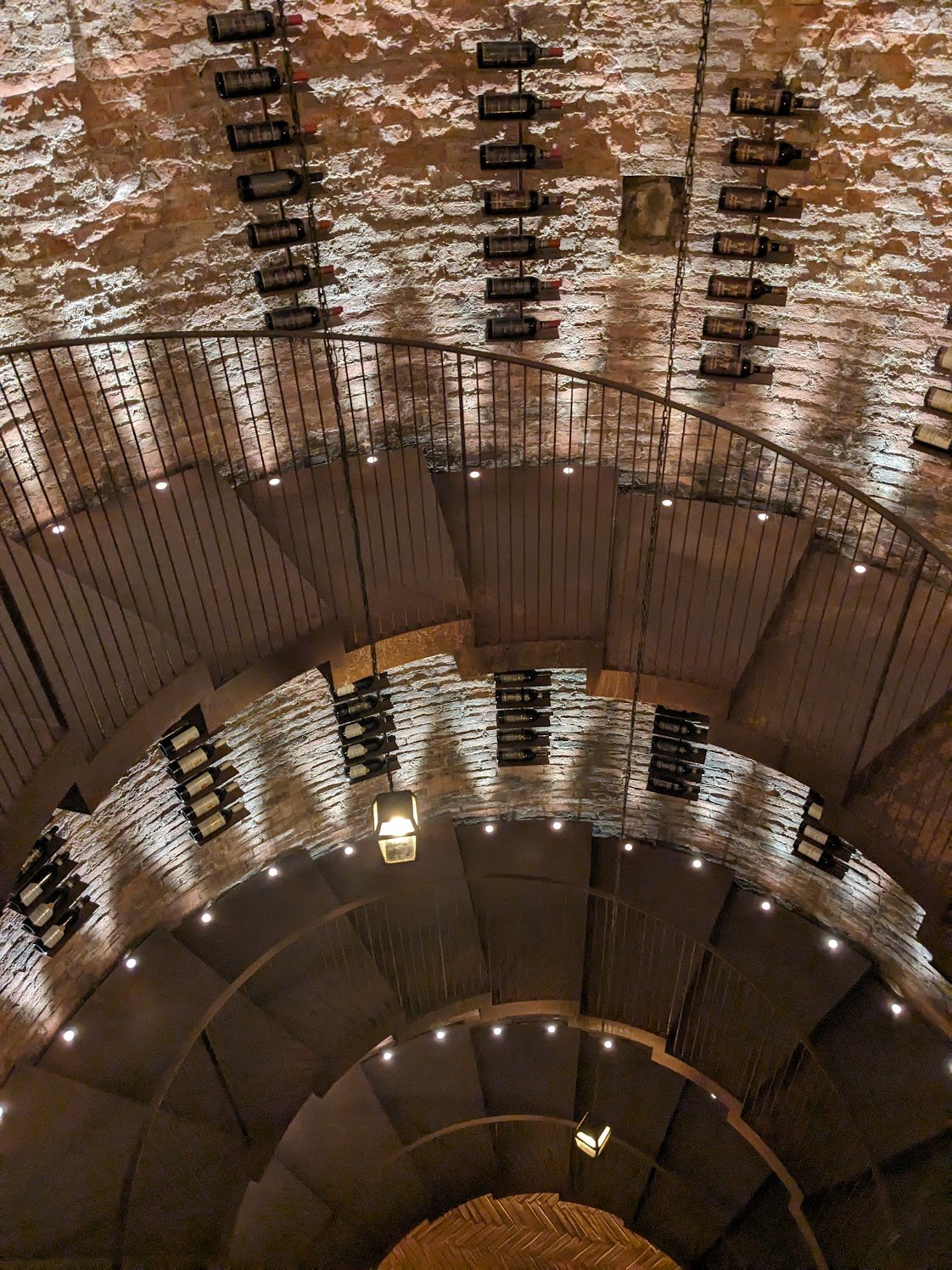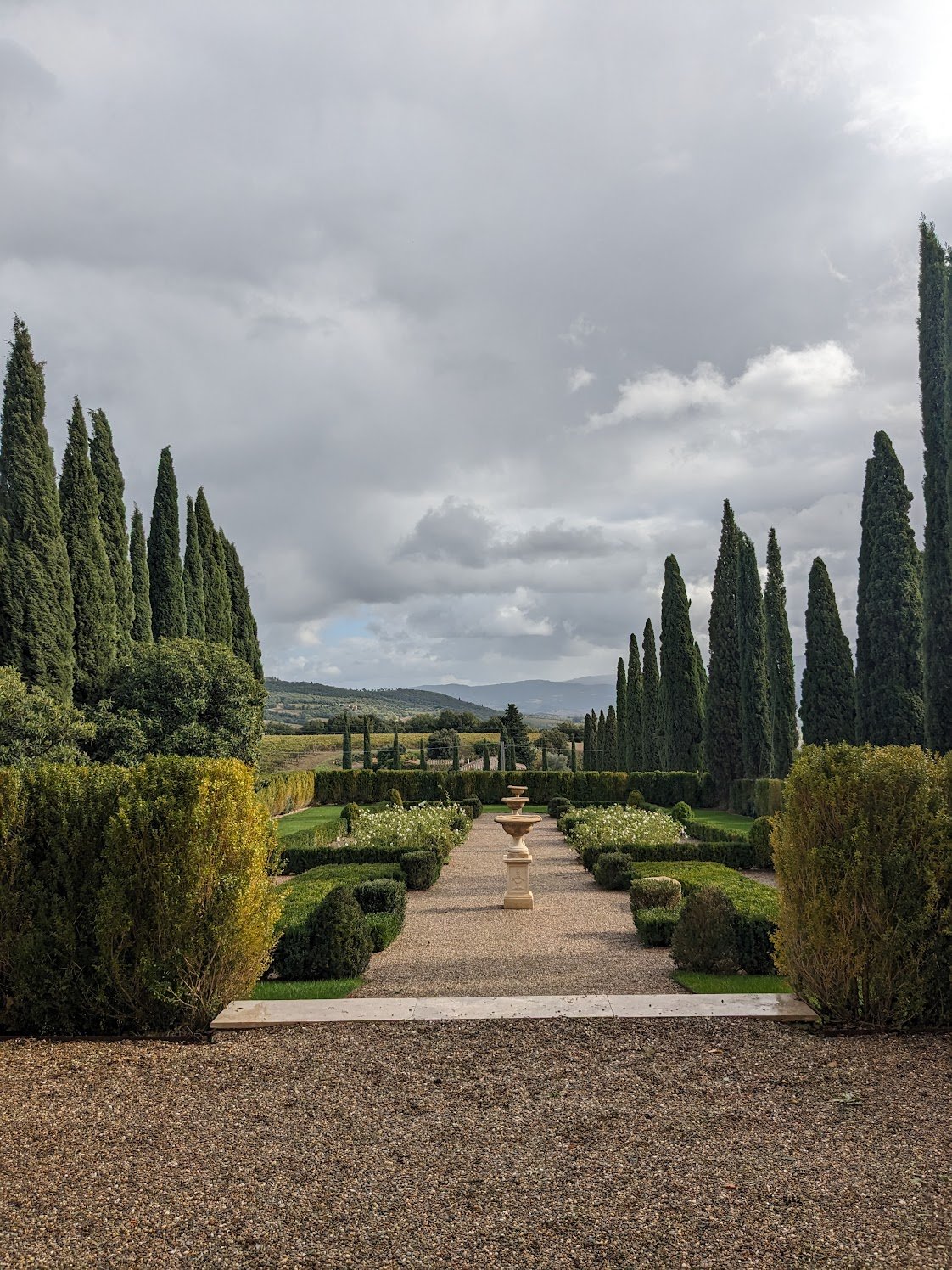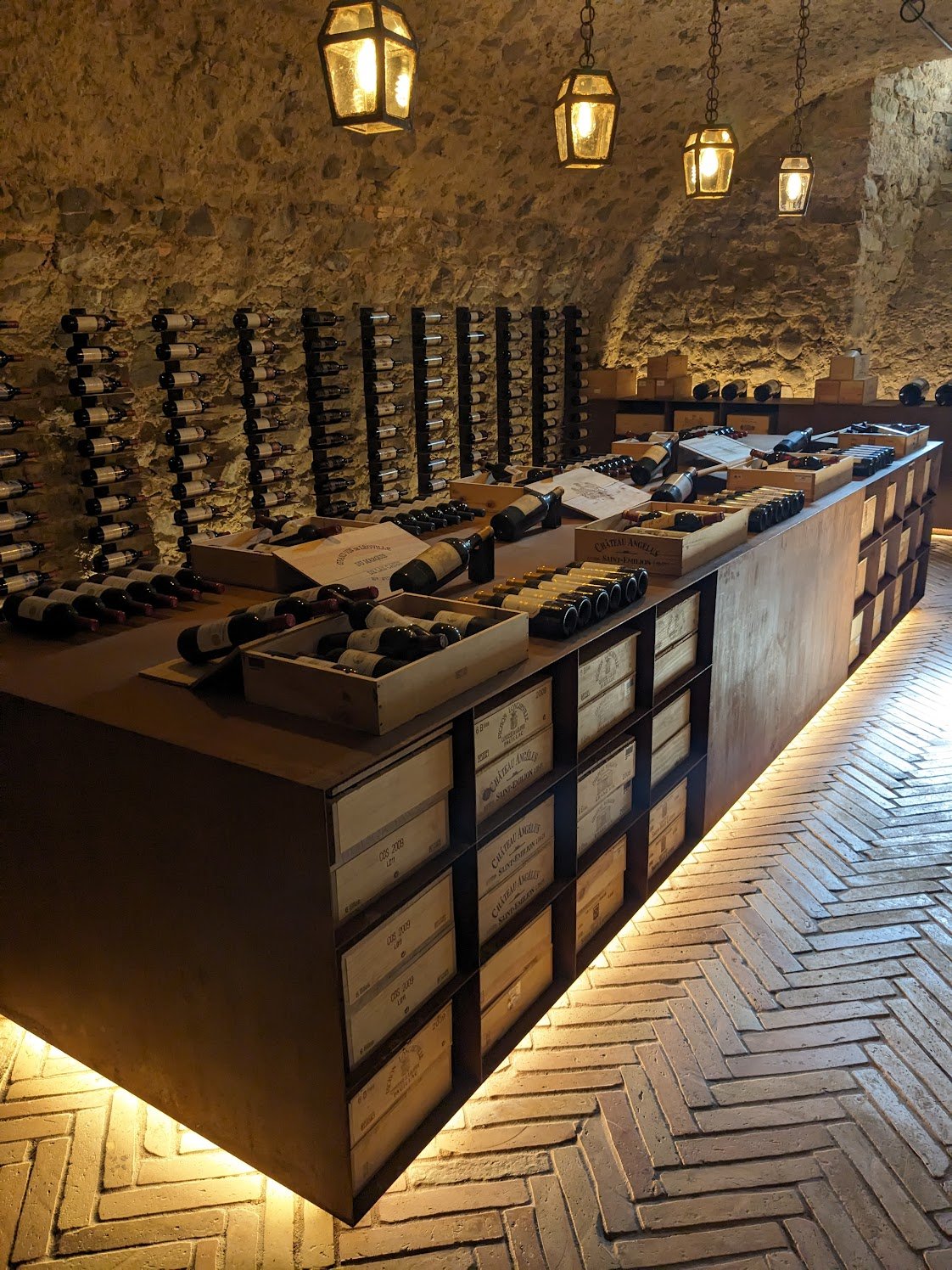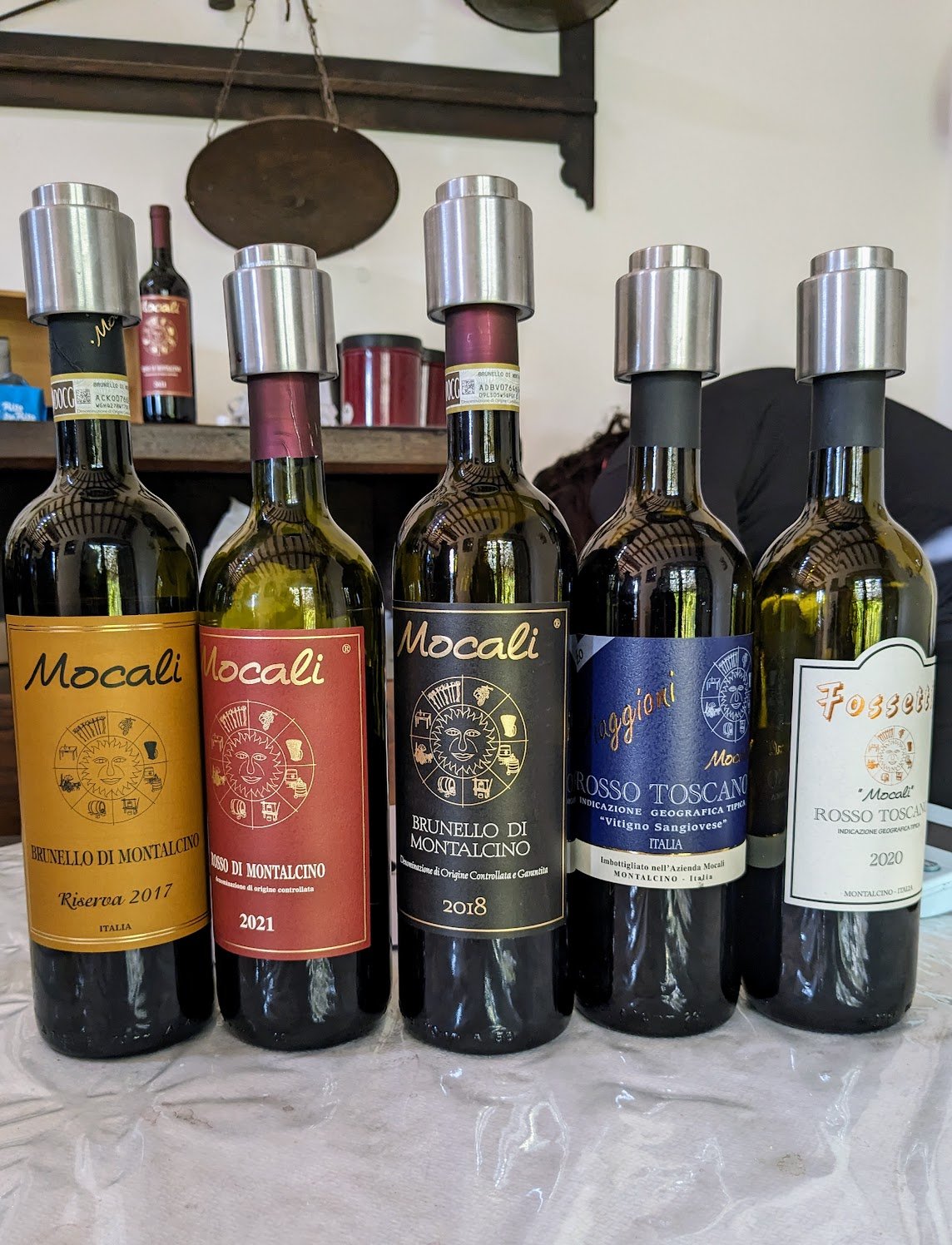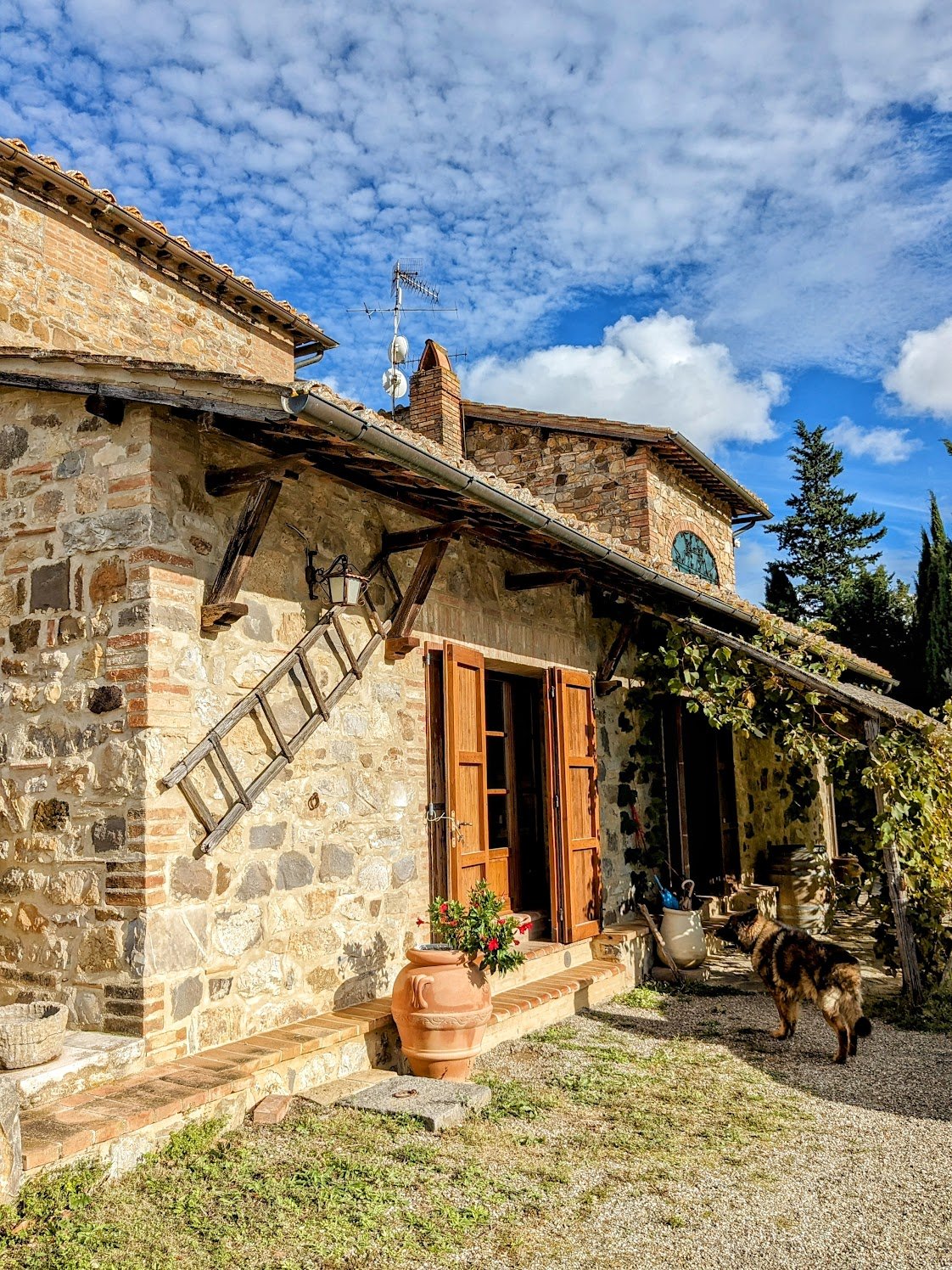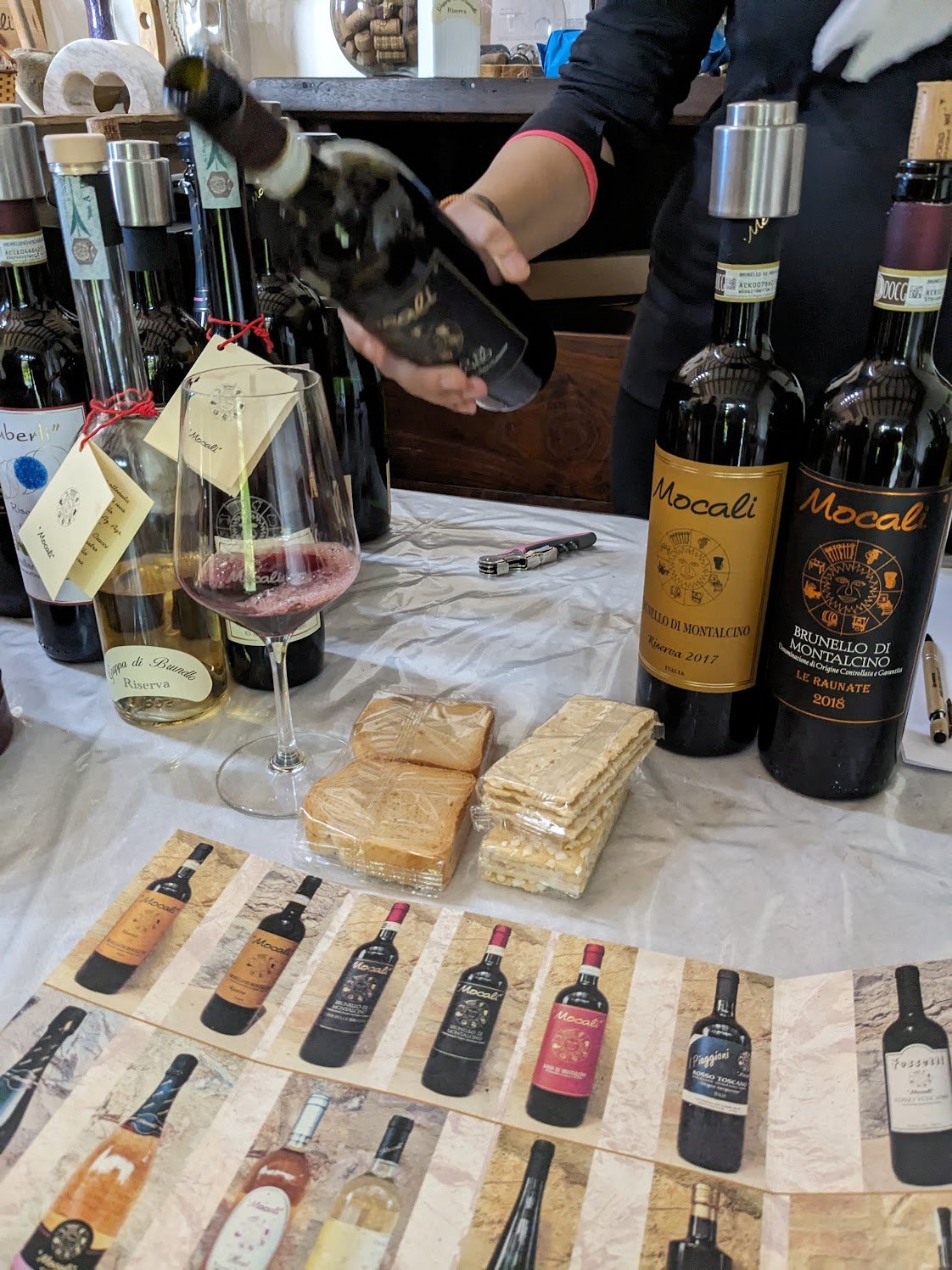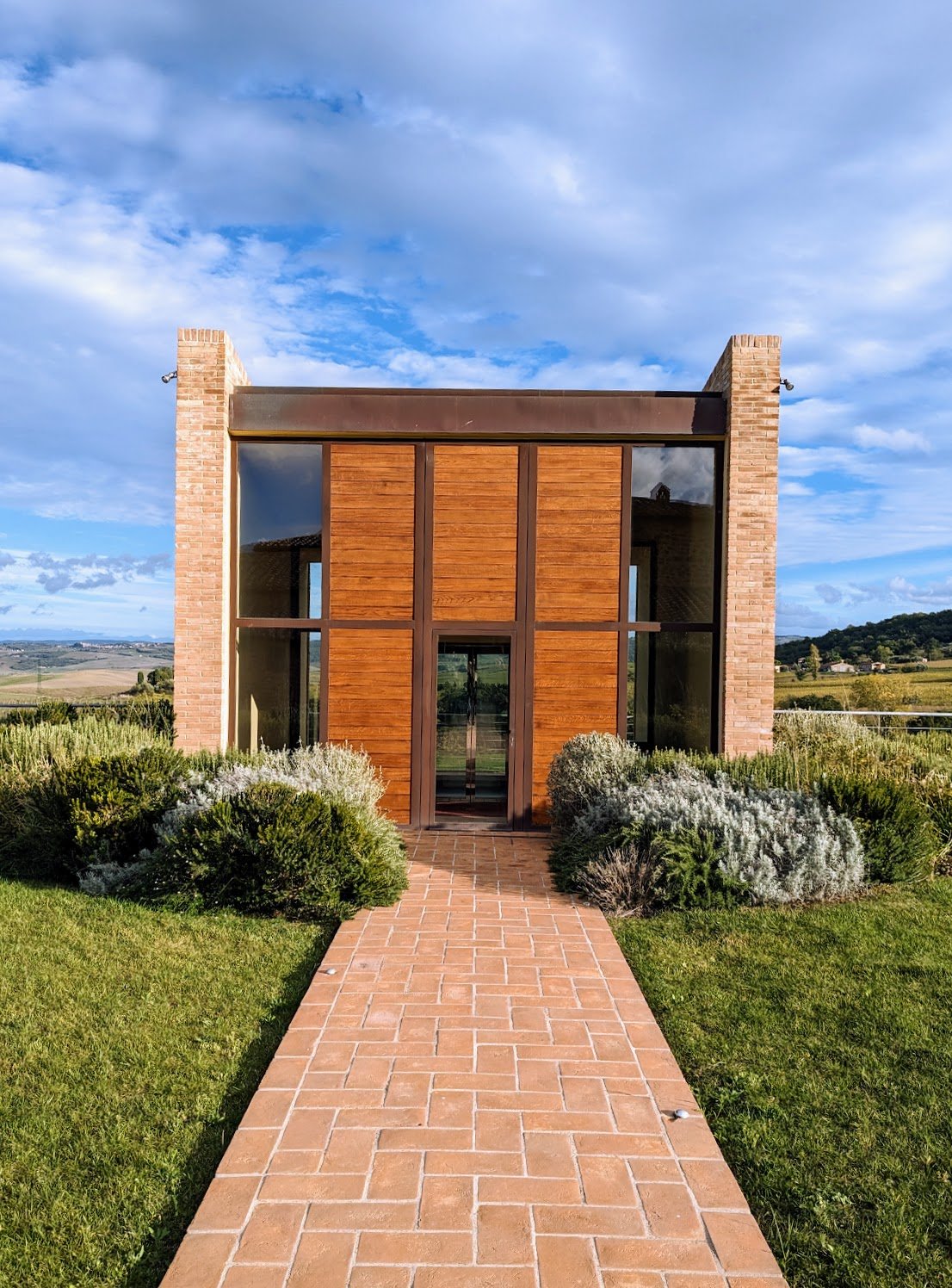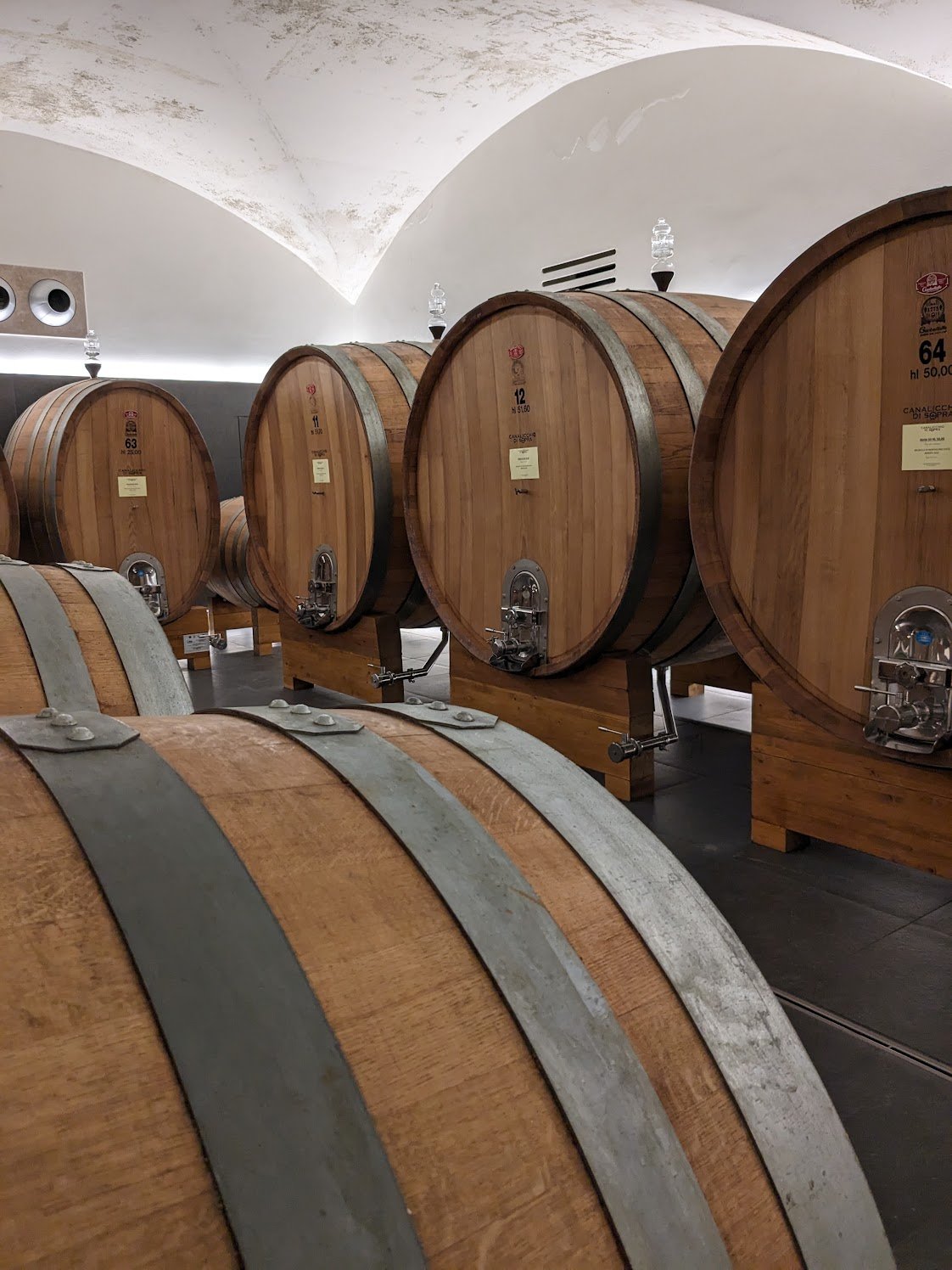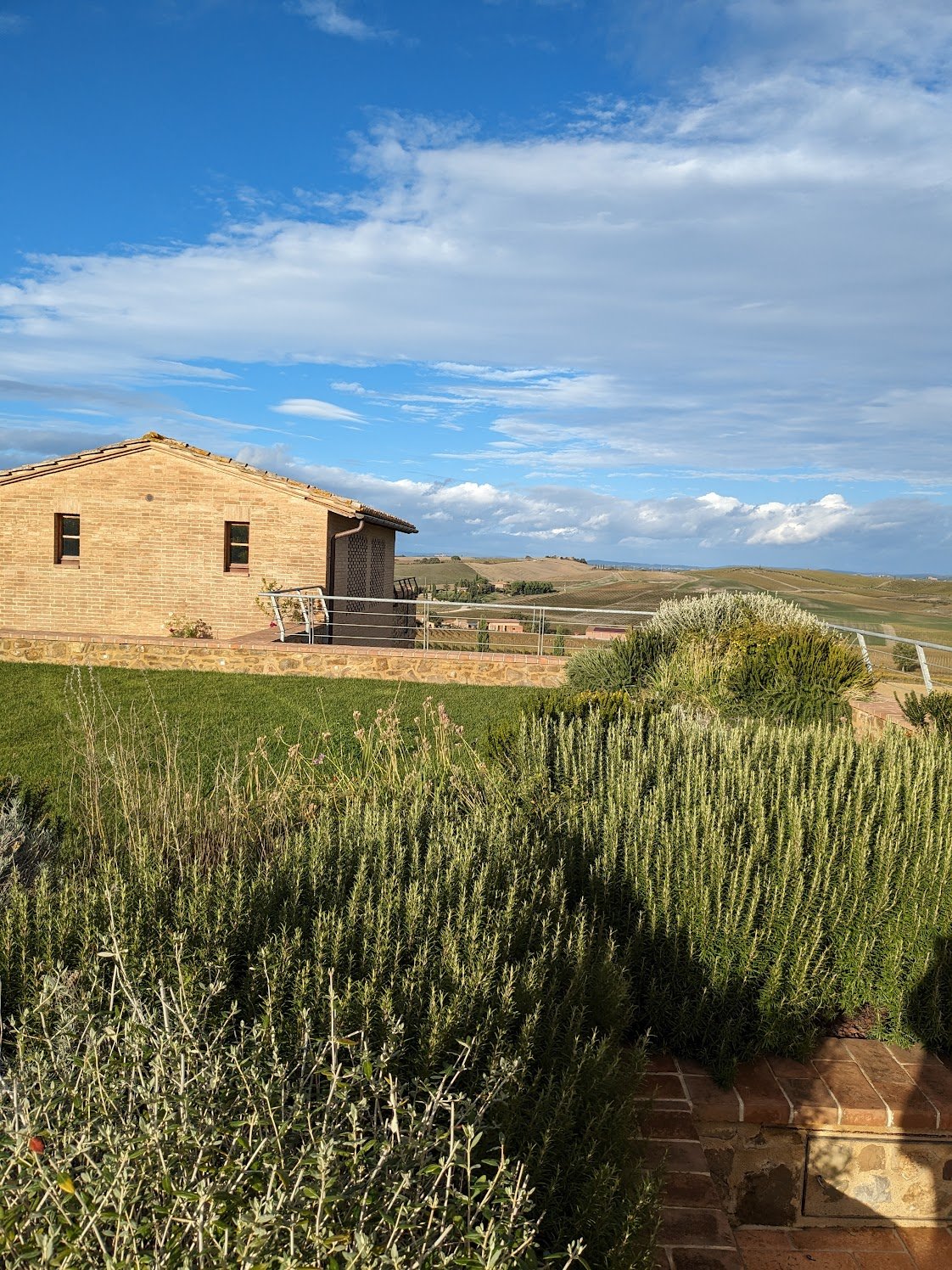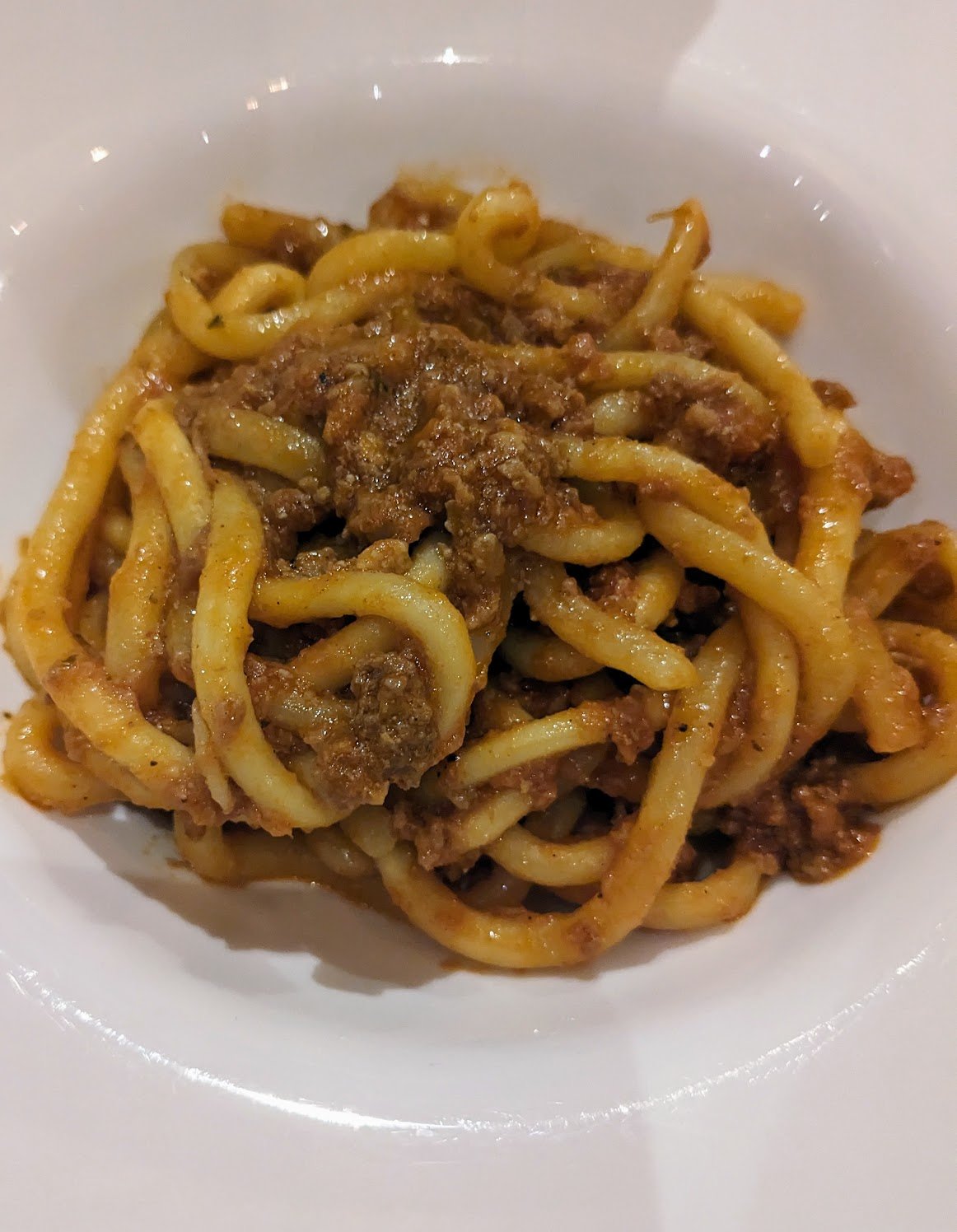My Weekend in Montalcino
The medieval, mountain-top town of Montalcino will leave you undeniably awestruck. The scenic streets are full of charming shops and traditional Tuscan eateries, along with fortresses that date back to the 10th century BC. Panoramic views of perfectly manicured vineyards had me eager to explore Sangiovese at its best. We toured eight wineries, had some remarkable meals, and stayed at this Airbnb in town.
First stop was Il Poggione, one of the first wineries to market Brunello di Montalcino in the early 1900s. They own over 300 acres of vines, and the winery (built in 2004) is located 15 minutes south of Montalcino by car. Upon arrival, the team were harvesting olives, and completed the ‘23 wine vintage two weeks prior. We tasted the 2021 Rosso di Montalcino, aged in a mix of large Slavonian cask and small, French barrique. Barrique aging for Sangiovese is considered a modern winemaking style, but this was well-integrated and we did not pick up on oak-influenced tasting notes. It was pleasant and ready to drink with notes of violet, apricot and eucalyptus. The 2018 Brunello was aged 36 months in Slavonian cask, with bold flavors of tobacco smoke and cherry jam. While beautiful today, it was clear that this wine had another decade before reaching its peak.
Our next stop, Col d’Orcia was just 5 minutes south of Il Poggione. In fact, the two estates were together under the name Fattoria Sant’Angelo until 1933 when Lavinio Franceschi’s grand children split land ownership. 400 of the estate’s 1350 acres are dedicated to vines, 2/3 of which are Sangiovese. The estate has been certified organic since 2013, but practicing since much longer. They are the largest organic winery in Montalcino, and 3rd in terms of Brunello production. We tried several delicious wines here, including the 2021 Rosso di Montalcino. The fruit comes from their Sant'Angelo hill, 250 meters above sea level and southern-exposed, overlooking the Orcia river. It was fermented around 10 days in temperature-controlled tanks before 9 months of aging in Slavonian cask and concrete tanks. Berries and spices fill the nose, with lifted acidity from the cool vintage to follow. Another standout was the 2015 Brunello di Montalcino Poggio al Vento. This single vineyard faces the ocean, and the fine, sandy soil is filled with fossils beneath the vines. It was aged three years in Slavonian and Allier casks before 16 months of refinement in bottle. There is an elevated tannic structure, with notes of blackberry, dried herbs and leather. I’ll be letting my bottle rest for another seven years at least.
Casanova di Neri was next, just 5 minutes East of Montalcino. The notorious, Giovanni Neri founded the chemical-free winery in 1971. The estate produces ten wines from their 185 acres of seven very different plots, in terms of soil composition, exposure and microclimates. We tasted their lovely rosé of 100% Sangiovese. This saw 12 hours of skin contact before fermentation and six months in steel tank. Another memorable wine was the 2018 Tenuta Nuova from the Citrine Vineyard. Ripe raspberries, fig jam, aniseed and graphite were my notes on this lengthy Brunello, aged in tonneaux for 30 months. Firmly structured, this will be drinking best in 15 years.
Our last stop on day one was Franco Pacenti, at the foot of the Montalcino hill, on the north-eastern side, a few minutes from Montalcino. Founded by Rosildo Pacenti in the '60s, the winery is run by the third generation of the Pacenti family today. Rosildo was the cousin of Siro Pacenti, another infamous winemaker of the area. Their 24 acres of vines are within the optimal, Canalicchio basin, a classic and historic area for winemaking. They only produce 3 wines and only have the Sangiovese grape for Rosso di Montalcino, Brunello di Montalcino, and Brunello di Montalcino Riserva. Only eight thousand bottles of the 2020 Rosso were produced, as it was a very warm vintage. Aged ten months in Slavonian and French barrels, this wine had elegant depth and ripe red fruit across the palate. The 2018 Brunello di Montalcino was characteristic of the cool vintage in the North. Harmonious and well-balanced with a lighter mouthfeel and overall approach, it was aged 30 months in medium and large Slavonia and French barrel.
Our first stop on day two was Capanna, located 10 minutes North of Montalcino in the celebrated Montosoli area. Capanna was the 15th ever winery in Montalcino, when the Cencioni family of farmers arrived in 1957. Amadeo Cencioni, 4th generation of winemakers, is still living on the property and making wine today at age 91. Everything here is hand harvested and all the tanks used are wood. They age all wines traditionally, in large Slavonian oak. Capanna produces a few white wines from the Moscato Bianco grape, and one from Sangiovese! They make about 70,000 bottles a year, but production this year was cut in half as 2023 proved to be a very difficult and rainy vintage. The 2017 Brunello di Montalcino was a stand-out for me, complex aromas of just-ripe plum, vanilla bean and mint. The 2015 Brunello Riserva was powerful and fruit driven with 45 days of skin contact. My notes include black olives, granite and cherry jam. The 2015 and 2016 were celebrated Riserva vintages for the estate and several others we visited.
Our second stop was the jaw-dropping Argiano Estate, 25 minutes south of Montalcino. We took a stroll through the beautiful gardens before entering the chateau, built in 1580. After touring the cellar, we entered the owner’s personal collection, and were surrounded by some of the rarest wines of the world. The estate is certified organic, and considered mid-sized with 350,000 bottles produced annually. They have 16 micro-terroirs of 160 acres, all situated 300 meters above sea level, on average. We tasted a few of the Rossos and Brunellos, of which the not-yet-released 2019 vintage stood out most. The ’19 Rosso di Montalcino had ripe blackberry and basil leaves on the nose, finishing long and elegant with fine tannins. The ’19 Brunello was full of perfectly ripe fruit and powerful structure, a fantastic vintage throughout the region, I’d wait 20 years to drink this.
Next was the 30 acre Mocali, a family run winery since 1990 just 12 minutes Southwest of Montalcino. They produce several wines, from sparkling blends to still rose and Brunello to Super-Tuscan style blends. Their Raunate vineyard is on a small river 650 meters above sea level, with a the high percentage of Balsano stone. The 2018 Brunello di Montalcino was in part from this vineyard, and the rainy and hot vintage made this wine sturdy and full bodied. This rustic wine had spice and pepper on the nose, with ripe plums and balsamic on the finish. The 2019 Brunello di Montalcino was more restrained, since the vintage was less hot. I found it herbaceous and elegant with raspberries and thyme across the palate. I look forward to putting this away for a decade once released this January.
Canalicchio di Sopra was last but definitely not least on our tasting trip, located 5 minutes northeast of town. The third generation of owners have around 200 acres which includes the infamous La Casaccia and Montosoli vineyards. Since 1962, this winery has paved way for Brunello greatness as one of the twelve founders of the Consorzio del Vino Brunello di Montalcino. The 2018 Brunello di Montalcino Montosoli was delicate and complex, with tomatoes, ripe cranberry and fresh basil on the nose. Only six producers in Montalcino are allowed to use Montosoli on their label, due to geographical restrictions. The more masculine 2018 Brunello di Montalcino La Casaccia had more tannin and earth-derived notes, likely due to the five-year older vines and Northeast facing hillside. Two very different single vineyard wines with great potential to age and evolve another decade.
Where to eat in Montalcino
Locanda Demetra: A field to table, organic farm and cooking school in the countryside. Serving lunch only with just a few tables, book in advance.
Grotta del Brunello: An enoteca with traditional Tuscan staples and an extensive wine selection adorning the walls.
Terra Cucina e Cantina: An innovative menu in a sophisticated setting. Think veal sweetbread, pigeon and truffle tagliatelle.
Villa le Prata: Boutique hotel, winery, and restaurant with impeccable service. Snag the cellar table for a cozy and intimate dining experience.
Osteria di Ports Al Cassero: Solid, Tuscan comfort eatery in the middle of town with a rare wine list and highly educated staff. The chickpea soup with crunchy bread and roasted rabbit over polenta were phenomenal.
